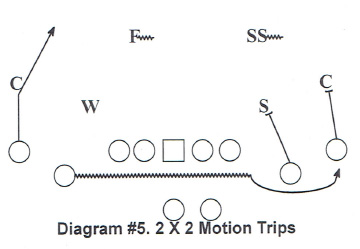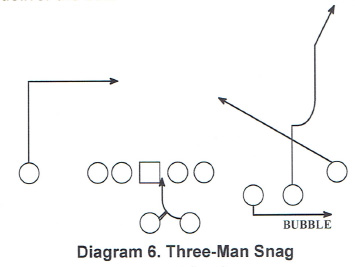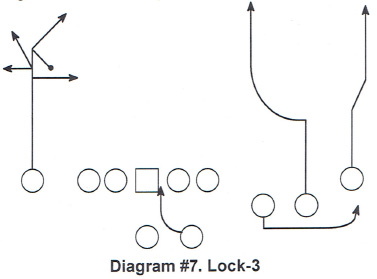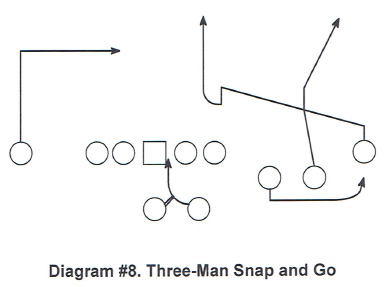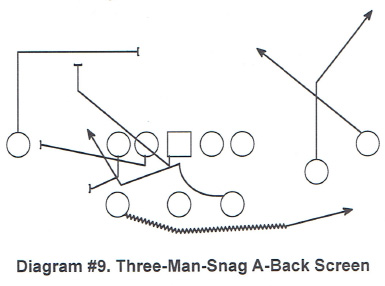| The Inside Zone With Multiple Screens |
| By: Paul Morrell - Wilbur Cross High School (CT)
Originally Published - Nike 2015 Coach of the Year Clinic Notes - by Earl Browning
Inside Zone and Quick Screen • Why Simplicity? Fewer plays with more production • Never a bad situation • Get the ball to the play makers • Players cannot take a playoff "TEAM" We broke it down and tagged our run game. Everything we did with the inside zone play, we tagged a perimeter screen with it or a quick game pass play. When the quarterback came to the line of scrimmage, he had multiple options. Our feeling was we could never be wrong. The reason we did this was we had fewer plays in the offense but we wanted more production. There were many hardships we had to deal with. We did not have a lot of time. but no one these days has. However, we had even less. Many of our kids are not going on to be rocket scientists. We have maybe five players with the ability to become D-1 football players. However most of them cannot qualify for a scholarship. On first down, we can come to the line of scrimmage with an inside zone call. If the defense has the box loaded with six or seven defenders; That is no problem, we simply go to the bubble screen. If they have four defenders over three receivers, we go to the one-on-one on the backside. Everyone on the offense has a job to do and you have three different things going on with one play. Another reason we went to this scheme, was to get the ball in the hands of the play makers. My slot receiver is the second best running back on the team, You do not want this players setting on the bench because you have some stud at running back. We want him in the game so he can make plays. If the defense loads the box and takes away the best running back, we have the option of going to the next best running back on the team. If they take away the running back and the slot receiver, I still have my best wide receiver they must cover in a one-on-one situation. I must have a way to get the ball to my play makers. every down. Years ago when I had good players that went on and played college and pro football. I had a chart that had ways to get the ball in those play makers. hands. Now I have created a situation where I am getting the ball in the hands of my play makers. as much as possible. Most wide receivers are prima donnas. They want to catch the ball and score touchdowns. This year at the first all-star meeting we had, I told the wide receivers they were all great and were the best or they would not be here. However, you must understand one thing. If you cannot block for each other. you are not going to play." They knew that every time I have the zone called, they must block because there is also a bubble screen possibility. If they do not block for each other they were going to sit. I did not care how good a receiver they were. if they did not block they were hurting the team. There are receivers who take plays off and do nothing. This prevented that from happening. I started running the bubble screen back in 1998 after a Nike Clinic. At that time it was in Hartford. When John Hevesy was at Brown and gave a presentation on the bubble. Lenny Corto was the head coach in New Britain where I was offensive coordinator and we first learned this at that Nike clinic from John Hevesy presentation. Later we drove up to Brown and talked to them for five or six hours about nothing but the bubble screen. We were a big powerful football team and we wanted to do something to open up the running game. We wanted to sling the ball to the perimeter to the play maker and let them do their thing. When we put the bubble screen into the offense, we had to talk to the officials before the game about running the play. They warned us to make sure the ball was thrown behind the line of scrimmage. The game has evolved and everyone is throwing the bubble screen. I have been in love with this play forever. I became offensive coordinator in Cromwell with Sal Morrelo. We were an 11 personal spread team and the quarterback had the freedom to check to the bubble on any play, and freedom to check to the quick game as well. We believed in throwing to uncovered receivers. On 3rd and inches, if the slot was uncovered we were checking. Teams could not leave players uncovered. I became the head coach in New Britain. and became good friends with Rob Likens who was offensive coordinator at CCSU (Connecticut Central State University). Rob and Charlie Eger who is the offensive coordinator at Seaton Hall now, would spend hours talking football with me. They sold me on packaging the power with the fast screens. That was taking the 2 best plays in football and putting them together. We want to get the ball in the crease and make the one-on-one play. Everyone has one guy on their team they trust to make a move on someone. We want to get our best against the defenses weakest. Who is the worst tackler on a football team? Nine out of ten times it is the corner. I want my best player against your worst tackler. If you call the inside zone. come to the line, and the box is loaded, what do you do? If you call an audible everyone in the stadium sees the quarterback calling the audible. The defense adjusts and calls an audible. If you try to go to the bubble screen it is too late. We do not call an audible. We run the inside zone play. The quarterback does not run the inside zone, he throws the bubble screen. We do the same thing with the power. If the numbers are not good for the power. we have two guys on the perimeter running the bubble screen. The offensive line blocks the power, but the quarterback and receivers run the screen. I went to Wilbur Cross as the offensive coordinator. The first year there we had issues. The school is located in New Haven, which is the number one most violent city in Connecticut. Most of the players come from single parent homes and are living on or below the poverty level. We did not have buses to transport the players' home. They had to catch city buses. Now we had to worry about them getting shot or something worse happening to them on the way home. They could not afford the bus fare so they ended up riding a bike home. Because of that we have to end our practices at 5:30. That gave them enough daylight to ride home. While most teams were still practicing, we have to worry about our players getting home without getting shot at or being hit with a hammer. Many of our players go to magnet schools and they do not get out at the same time. Our quarterback went to a magnet school and was not there at the beginning of practice. We cannot have a pre-practice at any time. Because of the school policies, we could not bring our players in on Sundays. We had no time when we could meet with them. We did have staff meetings to discuss what we were going to do in practice that week. We run the inside zone, screen, and quick game. We could not run power because it required too many adjustments for different fronts. We did not have time to practice those adjustments. We did not have time for film study or any of the normal things you do with a team. I could not define my player's roles within the offense. I know that sounds nuts, but that was the situation we had. I have two hours at tops to practice with my players and get them home. The only way I could do anything extra was with Hudl. We have the greatest athletic director around. We have the greatest administrative staff. and the players are hands down, the nicest. greatest, most appreciative players around, but we still have these constraints to deal with. We had package restraints, social-economic problems and only six paid coaches. We could not use volunteers. We had six coaches and two of them were freshman coaches. We had four varsity coaches. To get the job done, you must be great at something. Our average player had a 710 math and verbal score. You talk about no child left behind", we had to teach our players how to study and learn. Along with all the problems, these kids had no father figure in the home and did not know how to accept authority. There were all these great schemes in football. but we did not have the time or the players to do the things we wanted to do. This was our answer. It did not take as much time and it was easy to learn because of the limited amount of things we did. With all the problems there were great rewards. Players leave knowing they have someone in their lives that cares for them. Love cannot be explained because it is having 100's of kids look at you as a father figure. Football is looked on as an escape from reality. Football is used as a tool to get a better life. You get to coach special athletes. It is nice to believe you saved a young man's life. These kids were the greatest kids in the world. I had players that had never played a down of football in their lives and they came to practice every day. For other players it was their way out of the neighborhood. Where we have advanced to today is great. We have the same time restraints but not all the other problems. We are going to keep it simple. We cannot send our players to camp and we cannot do it in a classroom. We cannot run a lot of plays because we do not have the time. We have 90 minutes of offense on Monday, 40 minute of offense on Wednesday and a quick walk through on Thursday. The retention is minimal at best. We cannot afford many passing leagues and transporting the players in a maxima is rough. We cannot afford any types of team camps or individual skill camps. It all has to be simple. I do what I can do. I teach the zone play, the screens, and the quick game and that is what we are going to do. Last year we had no returning linemen and an anatomical freak at wide receiver. Our quarterback ran a simple progression. We played six ranked teams last year. We ran one scheme with one set of rules. That kept it simple. We run our zone play, which works against any defense. My running back was a small back. He was not a big time bruiser. He is small but he can stick his foot in the ground and go. He has great vision. He is a special back but he cannot run the power, counter, and traps. This play works with a smaller running back. My quarterback was slow and only ran the ball five times last year. He ran enough to make the defense stay honest. He was tall. big, and his major asset was he could read defenses. If he came to the line and saw two defenders to our three receivers, he knew what to do. If we have the five-man box we are going to run the zone play. The quarterback will hand the ball off and act like he is throwing it. Our younger quarterbacks in the program all can move with the ball. When they get to this level, they will be a threat to run the true zone read. They will be able to read the defensive end. come down the line, and still throw the bubble off the run. They can read the defensive end. pull the ball and make the force player do something. If the force attacks him, he throws the bubble to the outside. When you watch UCLA and Oregon that is the kind of deal we want to run. Having the limited offense. we can maximum practice time. Last year, our small running back played nine and half games. He missed a game and half with injuries. He still gained 907 yards with 9 touchdowns. and averaged 4.4 yards per carry. The team rushed for 1353 yards. Rules • Offensive line all has same rule except last man play side • Reach play side combo where possible • Last man drive • Few line calls try for none • "Push Call" , "2 Up Call" I cannot stand line calls. I want to line up and snap the ball. There is no reason to call the linebackers on this play. (Diagram #1)
If the guard is covered, he zone steps to the play side and has a combination block with the center. They have a two-for-two block for the 1-technique and the Sam linebacker. The plays side tackle has a drive block on the 5-technique defender. The backside guard and tackle have a combo block for the 3-technique and the Mike linebacker. The quarterback reads the backside defensive end. If he closes on the running back, the quarterback pulls the ball and throws the bubble screen or the one-on-one pattern to the split end. If the Sam linebacker aligns at the line of scrimmage and comes off the edge, the tackle gives a "push" call. (Diagra On the backside of the zone play, we could get two defenders outside the offensive tackle. (Diagram #3) If the Will linebacker moves to the line of scrimmage, the backside tackle gives a "2-up" call. That tells the quarterback he has two defenders to the backside We number our receiver in the trips set from the outside/in. The wide receiver is number-1, the outside slot is number-2 and the inside slot is number-3. In this set we want the receiver to block, get the ball to the freaks, get our best receiver on their worst defender. and eliminate hole-players. Frank Stamilio, the Connecticut Nike Clinic Director, was my offensive coordinator at New Britain. He always said, "Do not let the overhang players serve two masters." Make them play in the box or in coverage. Do not let them play halfway. If he does not come out and cover the receiver, throw the bubble screen immediately. Make him chase that receiver down. If he comes out to cover the receiver, I have numbers in the box and that is what I want. We can get in a 2 X 2 formation and run quick screens to both sides with the inside zone play. The quarterback has his choice of throwing either way if any receiver is uncovered. One of the first things I want to know is how the defense is going to defend the trips set. Many coaches play trips only one way. That is the ideal situation for us. They have to commit four defenders to the trips side or balance with 3-on-3. Either way it helps me. What we like to do is run the glance to the single receiver side. (Diagram #4) To the trips side we run a bubble screen. To the single receiver side we run a glance pattern. The glance is not a slant and it is not a snag. It is a pattern that finds grass. He wants to work up the field in an area where the linebacker cannot get under him and he has leverage on the corner. It is a zone splitting pattern. He looks for open grass.
We run a stalk blocking scheme with the bubble screen. We can throw the bubble to any of the receivers. but the inside slot receiver is the most likely to catch the ball. The number-1 and 2 receivers come off the ball and have a MDM (most dangerous man) blocking scheme. If you are going to throw the bubble, you must do the stalk drills daily. If it looks like they are giving you the bubble screen. the backside nickel back or safety is committed to the trips side. They are playing four defenders over three receivers. When they commit the backside safety or nickel back to the trips side. the glance pattern is wide open. There is nothing deep to the inside but grass. That is what the single receiver is looking for. He puts the corner on his backside and runs away from him. We ran the inside zone many times this year and we were flagged for have an ineligible down field only one time. That is how quick the ball is coming out. If they commit the strong safety to the trips. the box is thinned out and you have numbers advantage with the inside zone. Let me go over our receiver personnel so you will have some idea how we use them. H-Receiver (number-3) • Had 41 receptions for 433 yards • Maximized bubble screen to most other concepts limiting the toolbox: making things simple • Never knew when he was getting the ball thus making him the master deception player • Year before he had over 700 yards receiving: running only. stick. out. bubble & jailbreak Y-Tight End: (number-2) • Y (My Guys) Dudes! Put hand in ground and got dirty when attached. and blocked like champs in space • Selfless players! • Big plays off of the screens 42 receptions for 671 yards. mainly off of PA seams, Flags, & Drags X-Receiver • The X was either on a screen or Glance, or Quick Game on most Zones. • He is the DUDE! • Getting 1-on-1's and kill, or will be eliminated by numbers and take up defenders • 10 Games 47 receptions 753 and had 2 games he was taken away with numbers'. Half his yards came off of Zone tags Z-Receiver: (number-1) • The Z Possession guy, and best blocker, big play opportunist • 26 receptions for 326 yards • Big PA possibilities • The A, H. Z receivers numbers slightly dropped this season & the X and Y numbers increased. Shows offensive philosophy take what they give you Our X-receiver was our go to receiver. In two games this year, the defensive committed to him and took him out of the game. When they did that they had to take defenders out of the box, which open the inside zone or they had to steal defender from the trips side which opened up the bubble. To stop the glance, the corner would drop to the inside to keep him from getting into the middle. When they did that we simply tagged the X-receiver with an out breaking pattern. They still had to tackle him after he made the catch. In this offense the quarterback does not need a great arm. He does not need to be mobile or be great at post snap decisions. In this offense he is never called on to block anyone. However what he does need is to be a leader. He has to be able to do math and count defenders. He must throw to spots but not necessarily receivers. He must read one defender in the post snap situation. We want him to carry out his ball fakes and be able to communicate. Lastly but very important is he must understand the system. He does not need to throw the ball 90 yards. He only needs to throw it quickly and to a spot. Right now because of our quarterback's ability, we are not pulling the ball and coming downhill attacking the read key. Next year we will and it will make this offense better. He has to count. If there is a 3-on-2 or 4-3 in the secondary, he has to know. He must be able to count the defenders in the box. We are going to sling the ball all over the yard to get five defenders in the box. If he does not carry out his fakes. I am on him. He must act like he is doing something every time he hands off the ball. How It Works • Offensive line Block the zone • Wide Receiver's run fast screen attached, or block for fast screen • Running Back run zone. If you do not get the ball run like you did • X Runs glance (get skinny, find Grass) or runs Quick game tagged • Quarterback Count • Play caller and staff let it be mundane and do not ever doubt it, never tell the Quarterback he is wrong The rules for the count are not rocket science. It is an easy way to count the box. Count • If 3-on-2 or 3-on-3. but off and soft. throw attached screen • 4-on-3 look to X for 1-on-1 • X has a glance (Not a slant, not a seam. it is really just finding grass) • If tagged X runs assigned tag • 3-on-3 / 2-on-1 / 5 read the EMOLS • 4-on-3 / 2-on-1 16 leaves 5 in the box. run the zone When we count for the bubble screen. if the safety is not within 12 yards of the line of scrimmage. he is not counted. Three over three. with a safety at 14 yards, is actually two defenders on three receivers, which is what we look for. This year, 30-40 percent of our calls was one play. On the inside zone. we align the running back on the inside leg of the tackle and even with the quarterback. The reason I align him there is to keep from giving away what the play is going to be. He can run the stretch and inside zone from the same position. On his footwork, he flat steps to the quarterback, crosses over, plants and gets square to the line of scrimmage. The read is the first defender head up the center working to the backside of the play. The quarterback steps to the running back and gets his eyes on the handoff key. He places the ball in the running back's gut. If he is going to give the ball, he slides his outside hands off the ball and presses the ball into the running back's gut. That way the running back can feel the ball and clamp down on it. If he is going to pull the ball. he leaves both hands on the ball. squeezes it, pull the ball, and get ready to throw. If the defense starts to jump you bubble screen, we align in a 2 X 2 set and bring motion. (Diagram #5) If there is no one following the motion across the formation, the twin receivers block the MDM scheme. and we throw the bubble to the motion back immediately. If the quarterback does not run the bubble, he still has the zone call and the glance.
If they roll the safety down into coverage, we run the zone play. If they run the Will linebacker or nickel back with the motion, we have the glance. When we throw a play action pass, we use what we call "AP-protection." • Comes off of the zone look. All offensive line blocks the same as they would on the zone but do not climb block • Same linebackers in run game as pass game • Backside offensive tackle has to lock onto the 5-technique • A back fake the zone and bends back. He is responsible for linebacker 2-3 weak • If weak side blitz A-back aborts fake and gets blitz pickup When people start jumping your bubble we throw a three-man-snag route. (Diagram #6) It looks like the bubble from the beginning. The number-3 receiver runs the bubble route. The number-2 receiver fakes the stalk block on the flat defender, but turn his pattern into a corner route. The number-1 receiver comes inside like a crack block on the first defender to the inside. He by-passes the defender and runs a snag route. It is a six yard slant coming inside and hooking up. The quarterback has numerous windows to deliver the ball.
The backside pattern for the X-receiver is a 10 yard dig route coming into the middle. The snag route with the play action should pop wide open off the linebacker and safety displacement. When the safeties and corners start to creep down we give a "lock-3" call. (Diagram 7) The number-3 receiver runs the bubble as usual. The #1 and #2 receivers start in their stalk block routine. With the safety and corner coming down. the #1 and #2 receivers turn their stalk blocks into vertical routes. The #1 receiver works the boundary and the #2 receiver works the seams. The single receiver side can have any number of tags added to these patterns.
I want to show you two plays off the three-man snag. The first one is the "snag and go." (Diagram #8) This works with a single high safety or a two high safety. You can put window dressing on it with motion. We align with the H-back in the back field and motion him out into the bubble pattern. The outside slot receiver runs the corner. The wide receiver comes inside on his snag route. If the strong safety rolls down to cover the snag, the #1 receiver breaks vertical up the field. He is in the middle.
The other pattern is the A-back screen from the three-man snag route. (Diagram #9) The receivers run their three-man pattern. The A-back fakes the inside zone and sets up behind the center. The offensive tackle to the side of the screen blocks the edge rusher and tries to cut him and get him on the ground. The X-receiver is the inside crack blocker. He comes inside and cracks on the first linebacker in the box. The play side guard is the kick out blocker. He pulls flat to the outside and blocks the force defender. The center pulls and is the alley blocker for the A-back. The A-back follows the timing of the linemen and gets into the screen.
I appreciate your attention. If you have any questions, I will be here for a while. Thank you very much. |



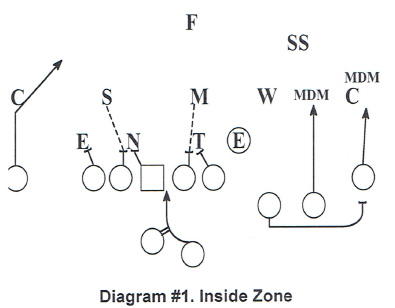
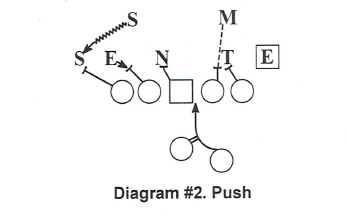 m #2) The center, play side guard, and play side tackle, block one man to their outside. The backside combo block for the 3-technique tackle and Mike linebacker is the same. The quarterback still reads the 5-technique defender to the backside of the play.
m #2) The center, play side guard, and play side tackle, block one man to their outside. The backside combo block for the 3-technique tackle and Mike linebacker is the same. The quarterback still reads the 5-technique defender to the backside of the play.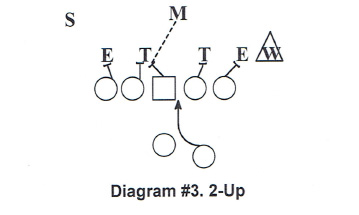 . The tackle blocks the 5-technique and the quarterback reads the Will linebacker as his handoff key.
. The tackle blocks the 5-technique and the quarterback reads the Will linebacker as his handoff key.
